TOPICS
|
Britains
First Climbing Walls
Although the first recognised
climbing wall was the Schurman Rock,
built in the USA in the late 1930's and in France they were making
adjustable wooden climbing walls in the late 1950's¹,
it wasn't until 1960 that the first wall was built in Britain. It
wasn't long before the modern climbing wall as we know it then
emerged from the architect walls to wallls designed and used by
climbers to develop their skills.
The First
Climbing Walls
The first climbing wall was
built at Ullswater school in Penrith, in the North of England in
1960.
The basic design
concept of this wall was widely copied and improved upon
throughout the 1960s and early 1970's, such as the University of
Bolton Climbing Wall on Deane Road, Bolton opened in May 1969
and still in use to day.
The Bolton University wall
shows a broad range of the development of the climbing wall
systems from the early "Architect wall" through
modifications of the wall to DIY constructed structures to
modern commercial constructed structures.
|
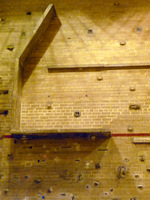
University Of Bolton Climbing
Wall |
Ullswater
School
The Ullswater School Climbing Wall was the first climbing wall
built by the then Cumberland Education Authority and the first
climbing wall built in England, UK. The Cumberland Education
Authority continued to develop the ideas and introduced more complex
facilities culminating in the Wyndham Tower in 1965.
The
fact that the first wall in Britain was built in at Ullswater
School in Penrith an area with lots of natural outcrops nearby
may seem strange but it is precisely this reason that is was
probably built, as there was already an interest in the activity
right from the start. It echoes the comments 30 years later when
people said, why does Sheffield need a climbing wall, nobody's
going to use a commercial wall when Stanage is only 5 miles
away.
Tynefield School was a girls
school built in about 1957 adjacent to it was the Ullswater Boys
school. The gym was uilt in 1960. The Climbing Wall consisted of
reccessed and protruding bricks with brick and concrete ledges
and a bar at the top of the wall for top roping from.
|
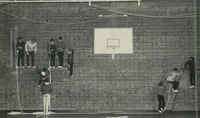
Photo by
Charlie Wilson who was the outdoor education advisor to the then
Cumberland Education Authority at the time and a prominent
Carlisle based climber along with people like Dennis English who
had the Carlisle climbing equipment shop in 1960's/70's
|
One
of the childrens activities practiced on the wall was Pirates,
having a class of children hangin off the wall while one (the
pirate) chased them. Bren McManus tells that Pirates was when
they had 2 or 3 classes, about 60 children, they put all the
equipment out and a few mats on the floor. One or two kids were
give a band and were pirates, if they touched anyone they were
Out, on the side or packed in the mat store, also out if they
touched the floor. If the pirate touched the floor all were
allowed back onto the equipment. The kids liked it especially
when they climbed into the roof space and the pirate was scared
to follow. Bren also says that it's, not allwed now, and, thank
god we had a few injuries but that was part of life and again
thank god no great injuries.
In 1970 the Ullswater School got a
new sports hall and a new climbing wall built on the outside.
The climbing wall was the same 'architect design' but bigger and
more complex. In the late 1980's Bren and Malcom Cane added bolt
on holds to it. This was used until recently when Ronnie Kenyon
managed to get a modern wall constructed about 50m from the
original. So the school has maintained an artificial climbing
wall for over 50 years. |
From the first
experimental wall at Ullswater school the Cumberland Education
Authority continued to develop their ideas into more and more
complex schemes for 5 years and culminated in The Wyndham Tower.
At the Time of construction, 1965,
the Wyndham Tower was the most advanced, complex and costly wall
built in Britain well into the 1970's. Not only was the
construction complex but it was housed in a purpose built tower
block.
Most of the Early Cumberland
Education Authority walls were built indoors for the same reason
as that the Sheffield walls were constructed, it rains a lot in
Britain and Winter day light hours are very small.
|
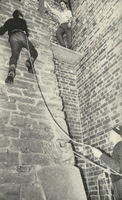
Wyndham Tower
1965, Wyndham School, Egremont (Pic. BMC) |
The Ullswater School design
proved to be the most widely copied of all the early climbing walls
and worked equally well indoor or out, and many of these early
designs can still be found in sport centres or schools today.
Collectively they are known today as Architect Walls or architect
designed walls and are typically found on gable end walls of sports
hall.
The
Colin Mortlock Experience
In 1961, newly qualified teacher,
Colin Mortlock began to work at a Royal Wolverhampton School in the
West Midlands, with a new sports hall. On the gable wall he screwed
wooden slates to the wall and created a climbing wall. Over the
winter he used this wall in has spare time to develope his finger
strength and stamina. He therefore became the first person to use an
artificial climbing wall in this way, as a training aid to develop
his climbing techniques rather than merely to teach the fundamentals
of rock climbing, such as belaying, abseiling and basic techniques
such as the mantleshelf. The following year he soon realised that
this training had improved his standard greatly as he began to make
second ascents and early repeats of some of the hardest climbs
around at that time.
The Meadows
Boys Club
The Meadows Boys Club in
Nottingham was the first to break the mold and give an
artificial climbing wall that was used for training not only or
just to teach the fundamentals of rock climbing like belaying,
the mantelshelf, the hand jam and abseiling but was used to
increase the physical and personal skill levels. The wall was
originally built along the same lines as the original Cumberland
Education walls a simple architect wall.
From the start it was
revolutionary in the way it was used. Firstly they extended the
use of the wall by introducing aid climbing across the steel
framed roof structure.
|
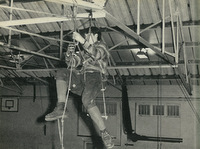
The
Meadow Boys Club Circa 1965 (Pic. BMC)
|
Next in 1962 they
modified the architect brick built wall by adding rocks to the
cavities. This simple act transformed he facility from a wall to
teach the principles of rock climbing to one that could be used
by climbers to train on. The success of this early project was
assured when Don Whillans participated at the reopening
ceremony. It was said that there was a notable increase in the
skill level and enthusiasm of Nottingham climbers over the next
10 years.
|
The Leeds
University Climbing Wall
The simple act of
choosing small rocks to embed into old climbing walls was used,
to full effect, by Don Robinson at the University of Leeds in
1964.
The physical education department
at Leeds University was responsible for modifying an existing
climbing wall.Like at The Meadows Boys Club in Nottingham in
1962.
Sections of the brick climbing
wall were removed and either left as a cavity or in filled with
natural rocks.
|
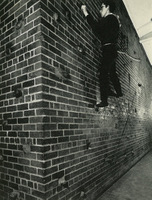
The Leeds
University Climbing Wall Circa 1970 (Pic. BMC) |
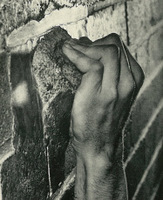
The Leeds University Climbing
Wall Circa 1970 (Pic. BMC) |
It was a
combination of the careful choosing and placing of these inset
rocks but more importantly the way that the climbing wall
facility was used that made the Leeds Wall an iconic status
since it was built. It will always have that iconic status
because it was one of the first climbing walls used in a sport
environment for training by rock climbers.
Traversing for stamina. footwork, and finger strength were all
helped. This simple climbing wall, consisting of no more than
rocks set into a vertical brick wall, changed, even
revolutionized the climbing standards of Yorkshire.
The Wall was 'L' shaped with a
squash court in the L. Much later on DR Climbing walls put
sculpted panelled climbing wall in it and even later still addes
panels in the corridor opposite the original climbing wall.
|
| It
is sad that this historic wall was demolished about 2006.
Before it was demolished
Leeds University commissioned a short video of the wall and some
commemorative photographs. The famous or notorious “balance
move” was rescued from the wall but alas broken and is
currently awaiting funding for its repair and reinstatement
somewhere suitable. |
The
First Commercial Manufacturers
Commercial climbing wall manufacturers soon cottoned on to this new
development and by the end of the 1960's there were several
manufacturers offering a variety of climbing walls and products.
These manufacturers included, Dring and Birtlesand H. Hunt and Sons
Ltd. By the mid 1970's two familiar climbing wall manufacturers
Bendcrete Climbing Walls Ltd and
DR Climbing Walls were producing
Climbing Walls.
Dring and Birtles redeveloped the French 1950's concept of
adjustable wooden climbing walls These walls were built as units so
could be added to, they also had the advantage that climbs were
created on them using a peg board system that could be altered to
change the climbs.
H.Hunt and Sons Ltd were a
Liverpool based gymnastic equipment manufacturing company who
developed an adjustable timber based system marketed as the Windsor
Rock Climbing Wall, presumably because they were based at 89-93
Windsor Street, Liverpool. Incidentally, 17 year old, Ringo Starr
took a job there in 1957 as an apprentice joiner until 1960 when the
lure of Playing with Rory Storm And The Hurricane proved too much.
The main feature of H.Hunt and Sons adjustable wall was that it
stored vertically against the wall of a building and when pulled out
for use could be used on both sides. It created two different walls
or created a chimney and could be sited at different angles creating
slabs and overhanging walls. The surface was covered with holes so
that it resembled a peg board and therefore individual hand and foot
holds could be put in to create different climbs.
|
|
|
Material on
this site is all rights reserved -This is a non-commercial, historical
and hopefully educational website. No part of this site may be
reproduced, stored in a retrieval system, or transmitted in any form or
by any means without prior consent. |




